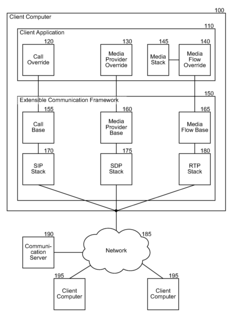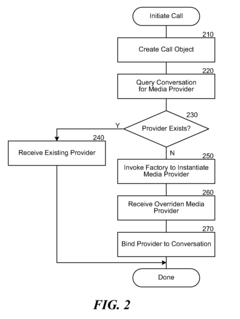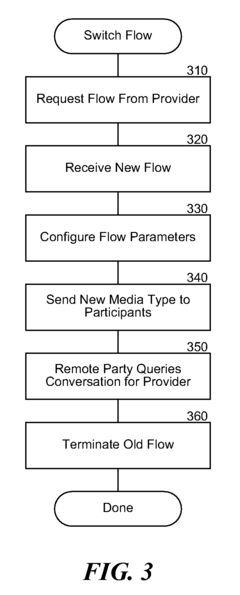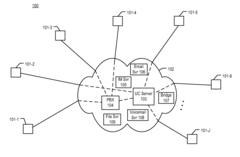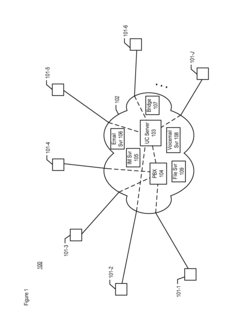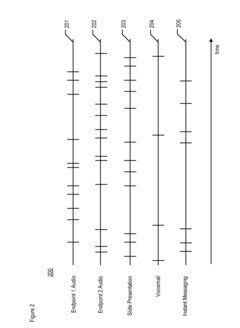How 5G UC Facilitates Real-Time Collaboration in Scientific Research
JUL 18, 20259 MIN READ
Generate Your Research Report Instantly with AI Agent
Patsnap Eureka helps you evaluate technical feasibility & market potential.
5G UC in Research: Background and Objectives
The evolution of mobile communication technologies has revolutionized various sectors, with scientific research being no exception. The advent of 5G UC (Ultra-Capacity) marks a significant milestone in this journey, offering unprecedented capabilities for real-time collaboration in scientific research. This technological leap builds upon the foundations laid by previous generations of mobile networks, each of which brought incremental improvements in speed, capacity, and reliability.
5G UC represents a quantum leap in network performance, characterized by ultra-high bandwidth, extremely low latency, and massive device connectivity. These features are particularly crucial for scientific research, where the ability to transmit, process, and analyze large volumes of data in real-time can significantly accelerate discovery and innovation. The technology aims to enable seamless communication and collaboration among researchers, regardless of their geographical locations, fostering a truly global scientific community.
The primary objective of integrating 5G UC into scientific research is to overcome the limitations of traditional communication infrastructures. By providing researchers with the ability to share and manipulate complex datasets, conduct remote experiments, and engage in immersive virtual collaborations, 5G UC has the potential to transform the very nature of scientific inquiry. This technology is expected to facilitate breakthroughs in fields such as genomics, climate science, particle physics, and astronomy, where the analysis of massive datasets and real-time collaboration are critical.
Furthermore, 5G UC aims to democratize access to advanced research facilities and instruments. Through high-fidelity remote access, researchers from institutions with limited resources can participate in cutting-edge experiments conducted at world-class facilities. This inclusivity is expected to accelerate the pace of scientific discovery by harnessing a broader pool of talent and perspectives.
The development of 5G UC for scientific research is driven by the increasing complexity and data-intensity of modern scientific endeavors. As research projects grow in scale and sophistication, the need for robust, high-capacity communication networks becomes paramount. 5G UC is positioned to meet these demands, offering the potential to handle the massive data flows generated by next-generation scientific instruments and simulations.
In conclusion, the integration of 5G UC into scientific research represents a convergence of technological innovation and scientific ambition. By providing the infrastructure for real-time, data-intensive collaboration, 5G UC is poised to usher in a new era of scientific discovery, characterized by unprecedented speed, scale, and inclusivity. The realization of this potential, however, will require continued investment, innovation, and collaboration between the telecommunications industry and the scientific community.
5G UC represents a quantum leap in network performance, characterized by ultra-high bandwidth, extremely low latency, and massive device connectivity. These features are particularly crucial for scientific research, where the ability to transmit, process, and analyze large volumes of data in real-time can significantly accelerate discovery and innovation. The technology aims to enable seamless communication and collaboration among researchers, regardless of their geographical locations, fostering a truly global scientific community.
The primary objective of integrating 5G UC into scientific research is to overcome the limitations of traditional communication infrastructures. By providing researchers with the ability to share and manipulate complex datasets, conduct remote experiments, and engage in immersive virtual collaborations, 5G UC has the potential to transform the very nature of scientific inquiry. This technology is expected to facilitate breakthroughs in fields such as genomics, climate science, particle physics, and astronomy, where the analysis of massive datasets and real-time collaboration are critical.
Furthermore, 5G UC aims to democratize access to advanced research facilities and instruments. Through high-fidelity remote access, researchers from institutions with limited resources can participate in cutting-edge experiments conducted at world-class facilities. This inclusivity is expected to accelerate the pace of scientific discovery by harnessing a broader pool of talent and perspectives.
The development of 5G UC for scientific research is driven by the increasing complexity and data-intensity of modern scientific endeavors. As research projects grow in scale and sophistication, the need for robust, high-capacity communication networks becomes paramount. 5G UC is positioned to meet these demands, offering the potential to handle the massive data flows generated by next-generation scientific instruments and simulations.
In conclusion, the integration of 5G UC into scientific research represents a convergence of technological innovation and scientific ambition. By providing the infrastructure for real-time, data-intensive collaboration, 5G UC is poised to usher in a new era of scientific discovery, characterized by unprecedented speed, scale, and inclusivity. The realization of this potential, however, will require continued investment, innovation, and collaboration between the telecommunications industry and the scientific community.
Market Demand Analysis for 5G UC in Science
The market demand for 5G UC (Ultra-Reliable and Low-Latency Communication) in scientific research is experiencing significant growth, driven by the increasing need for real-time collaboration and data-intensive applications. As scientific research becomes more complex and interdisciplinary, the ability to share large datasets, conduct remote experiments, and collaborate in real-time across geographical boundaries has become crucial.
One of the primary drivers of market demand is the exponential growth in data generation within scientific fields. Genomics, particle physics, and climate science are producing massive datasets that require high-speed, low-latency networks for efficient analysis and sharing. 5G UC's capabilities in this area make it an attractive solution for research institutions and laboratories seeking to enhance their data management and collaborative capabilities.
The rise of remote and distributed research teams has also fueled the demand for 5G UC in scientific settings. With researchers often spread across different locations, the need for seamless, real-time communication and data sharing has become paramount. 5G UC's low latency and high reliability enable virtual laboratories and remote experimentation, allowing scientists to conduct research collaboratively regardless of their physical location.
Furthermore, the increasing adoption of Internet of Things (IoT) devices and sensors in scientific research has created a need for networks capable of handling vast numbers of connected devices. 5G UC's ability to support a high density of connected devices makes it well-suited for managing complex sensor networks and data collection systems in fields such as environmental monitoring and precision agriculture.
The healthcare and life sciences sectors represent a significant portion of the market demand for 5G UC in scientific research. The technology's potential to enable remote surgeries, real-time medical imaging, and rapid sharing of patient data for collaborative diagnosis has garnered substantial interest from medical research institutions and hospitals.
Additionally, the demand for 5G UC in scientific research is being driven by the growing interest in augmented and virtual reality applications. These technologies have the potential to revolutionize scientific visualization, training, and collaborative problem-solving. The low latency and high bandwidth of 5G UC are essential for delivering smooth, immersive AR and VR experiences in research environments.
Government initiatives and funding for advanced research infrastructure are also contributing to the market demand. Many countries are investing in 5G networks and associated technologies to maintain their competitive edge in scientific research and innovation. This support is likely to accelerate the adoption of 5G UC in research institutions and universities.
One of the primary drivers of market demand is the exponential growth in data generation within scientific fields. Genomics, particle physics, and climate science are producing massive datasets that require high-speed, low-latency networks for efficient analysis and sharing. 5G UC's capabilities in this area make it an attractive solution for research institutions and laboratories seeking to enhance their data management and collaborative capabilities.
The rise of remote and distributed research teams has also fueled the demand for 5G UC in scientific settings. With researchers often spread across different locations, the need for seamless, real-time communication and data sharing has become paramount. 5G UC's low latency and high reliability enable virtual laboratories and remote experimentation, allowing scientists to conduct research collaboratively regardless of their physical location.
Furthermore, the increasing adoption of Internet of Things (IoT) devices and sensors in scientific research has created a need for networks capable of handling vast numbers of connected devices. 5G UC's ability to support a high density of connected devices makes it well-suited for managing complex sensor networks and data collection systems in fields such as environmental monitoring and precision agriculture.
The healthcare and life sciences sectors represent a significant portion of the market demand for 5G UC in scientific research. The technology's potential to enable remote surgeries, real-time medical imaging, and rapid sharing of patient data for collaborative diagnosis has garnered substantial interest from medical research institutions and hospitals.
Additionally, the demand for 5G UC in scientific research is being driven by the growing interest in augmented and virtual reality applications. These technologies have the potential to revolutionize scientific visualization, training, and collaborative problem-solving. The low latency and high bandwidth of 5G UC are essential for delivering smooth, immersive AR and VR experiences in research environments.
Government initiatives and funding for advanced research infrastructure are also contributing to the market demand. Many countries are investing in 5G networks and associated technologies to maintain their competitive edge in scientific research and innovation. This support is likely to accelerate the adoption of 5G UC in research institutions and universities.
Current State and Challenges of 5G UC
The current state of 5G UC (Ultra-Capacity) technology in facilitating real-time collaboration for scientific research is characterized by significant advancements and persistent challenges. 5G UC, with its enhanced capabilities, has opened new possibilities for researchers to collaborate seamlessly across geographical boundaries.
One of the primary strengths of 5G UC is its ultra-low latency, which enables near-instantaneous data transmission. This feature is crucial for real-time collaboration in scientific research, allowing researchers to share and analyze large datasets, conduct remote experiments, and engage in virtual laboratories with minimal delay. The high bandwidth of 5G UC also supports the transmission of high-resolution images, 3D models, and complex simulations, enhancing the quality and depth of collaborative research efforts.
However, the implementation of 5G UC for scientific collaboration faces several challenges. Network coverage remains a significant issue, with many research institutions and remote field sites lacking access to 5G UC infrastructure. This disparity in connectivity can create barriers to equitable participation in collaborative research projects, particularly for researchers in less developed regions or rural areas.
Security and data privacy concerns also pose challenges for the adoption of 5G UC in scientific research. The increased connectivity and data transmission capabilities raise questions about the protection of sensitive research data and intellectual property. Implementing robust encryption and secure communication protocols without compromising the speed and efficiency of 5G UC is an ongoing challenge for network providers and research institutions alike.
Interoperability issues present another hurdle in the widespread adoption of 5G UC for scientific collaboration. Different research institutions may use varying hardware and software systems, making seamless integration and data exchange across platforms challenging. Standardization efforts are underway, but achieving universal compatibility remains a complex task.
The cost of implementing and maintaining 5G UC infrastructure is also a significant challenge, particularly for smaller research institutions or those in developing countries. The high initial investment required for 5G UC equipment and the ongoing operational costs can be prohibitive, potentially widening the digital divide in scientific research capabilities.
Lastly, the energy consumption of 5G UC networks is a growing concern, especially in the context of sustainability in scientific research. The increased power requirements of 5G UC infrastructure may conflict with efforts to reduce the carbon footprint of research activities, necessitating the development of more energy-efficient solutions.
One of the primary strengths of 5G UC is its ultra-low latency, which enables near-instantaneous data transmission. This feature is crucial for real-time collaboration in scientific research, allowing researchers to share and analyze large datasets, conduct remote experiments, and engage in virtual laboratories with minimal delay. The high bandwidth of 5G UC also supports the transmission of high-resolution images, 3D models, and complex simulations, enhancing the quality and depth of collaborative research efforts.
However, the implementation of 5G UC for scientific collaboration faces several challenges. Network coverage remains a significant issue, with many research institutions and remote field sites lacking access to 5G UC infrastructure. This disparity in connectivity can create barriers to equitable participation in collaborative research projects, particularly for researchers in less developed regions or rural areas.
Security and data privacy concerns also pose challenges for the adoption of 5G UC in scientific research. The increased connectivity and data transmission capabilities raise questions about the protection of sensitive research data and intellectual property. Implementing robust encryption and secure communication protocols without compromising the speed and efficiency of 5G UC is an ongoing challenge for network providers and research institutions alike.
Interoperability issues present another hurdle in the widespread adoption of 5G UC for scientific collaboration. Different research institutions may use varying hardware and software systems, making seamless integration and data exchange across platforms challenging. Standardization efforts are underway, but achieving universal compatibility remains a complex task.
The cost of implementing and maintaining 5G UC infrastructure is also a significant challenge, particularly for smaller research institutions or those in developing countries. The high initial investment required for 5G UC equipment and the ongoing operational costs can be prohibitive, potentially widening the digital divide in scientific research capabilities.
Lastly, the energy consumption of 5G UC networks is a growing concern, especially in the context of sustainability in scientific research. The increased power requirements of 5G UC infrastructure may conflict with efforts to reduce the carbon footprint of research activities, necessitating the development of more energy-efficient solutions.
Existing 5G UC Solutions for Scientific Collaboration
01 5G Ultra-Capacity Network Architecture
The 5G Ultra-Capacity (UC) network architecture is designed to support high-bandwidth, low-latency real-time collaboration. It utilizes advanced technologies such as massive MIMO, beamforming, and carrier aggregation to provide enhanced capacity and coverage for seamless communication and data transfer in collaborative environments.- 5G Ultra-Capacity Network Architecture: 5G Ultra-Capacity (UC) networks are designed to provide high-speed, low-latency connectivity for real-time collaboration. This architecture incorporates advanced technologies such as massive MIMO, beamforming, and carrier aggregation to enhance network capacity and performance. The UC network enables seamless communication and data transfer for collaborative applications in various industries.
- Real-Time Collaboration Platforms: Specialized platforms are developed to facilitate real-time collaboration over 5G UC networks. These platforms integrate various communication tools, such as video conferencing, document sharing, and instant messaging, optimized for high-bandwidth, low-latency environments. They enable multiple users to work together seamlessly on complex tasks, regardless of their physical locations.
- Edge Computing for Enhanced Collaboration: Edge computing is utilized in 5G UC networks to bring processing power closer to end-users, reducing latency and improving real-time collaboration experiences. This approach enables faster data processing, content delivery, and application responsiveness, particularly beneficial for resource-intensive collaborative tasks such as augmented reality (AR) and virtual reality (VR) applications.
- Security and Privacy in 5G Collaboration: Advanced security measures are implemented to protect sensitive data and communications in 5G UC real-time collaboration environments. These include end-to-end encryption, secure authentication mechanisms, and privacy-preserving technologies to ensure the confidentiality and integrity of collaborative sessions, especially important for industries dealing with sensitive information.
- AI-Powered Collaboration Tools: Artificial Intelligence (AI) is integrated into 5G UC real-time collaboration tools to enhance productivity and user experience. AI-powered features include intelligent meeting scheduling, real-time language translation, automated note-taking, and predictive analytics for optimizing collaboration workflows. These tools leverage the high-speed, low-latency capabilities of 5G UC networks to provide seamless and intelligent collaborative experiences.
02 Real-Time Collaboration Platforms for 5G UC
Specialized collaboration platforms are developed to leverage the capabilities of 5G UC networks. These platforms offer features such as high-definition video conferencing, real-time document editing, and immersive virtual environments, enabling seamless remote collaboration across various industries and applications.Expand Specific Solutions03 Edge Computing for 5G UC Collaboration
Edge computing is integrated with 5G UC networks to reduce latency and improve the performance of real-time collaboration applications. By processing data closer to the end-users, edge computing enhances the responsiveness and reliability of collaborative tools, particularly in scenarios requiring instant feedback and interaction.Expand Specific Solutions04 Security and Privacy in 5G UC Collaboration
Advanced security measures are implemented to protect sensitive data and communications in 5G UC real-time collaboration systems. These include end-to-end encryption, secure authentication mechanisms, and privacy-preserving protocols to ensure the confidentiality and integrity of collaborative sessions across ultra-capacity networks.Expand Specific Solutions05 AI-Enhanced Collaboration in 5G UC Networks
Artificial Intelligence (AI) is integrated into 5G UC collaboration tools to enhance user experience and productivity. AI-powered features include real-time language translation, intelligent meeting scheduling, automated note-taking, and predictive analytics for optimizing collaborative workflows in high-bandwidth, low-latency environments.Expand Specific Solutions
Key Players in 5G UC and Research Collaboration
The 5G UC (Ultra-Capacity) technology for real-time scientific collaboration is in a growth phase, with increasing market size and advancing technical maturity. Major players like Qualcomm, Ericsson, and Huawei are driving innovation in this space. The market is expanding as research institutions and enterprises adopt 5G UC for enhanced data transmission and remote collaboration capabilities. While the technology is evolving rapidly, it is not yet fully mature, with ongoing developments in areas such as network slicing, edge computing, and ultra-low latency applications. Companies like Nokia, Samsung, and ZTE are also contributing to the ecosystem, focusing on specialized solutions for scientific research environments.
Telefonaktiebolaget LM Ericsson
Technical Solution: Ericsson's 5G UC solution for scientific research collaboration focuses on network slicing and edge computing integration. The company's dynamic network slicing technology allows for the creation of virtual network segments tailored to specific research requirements, ensuring dedicated resources and security[1]. Ericsson's Distributed Cloud platform enables edge computing capabilities, reducing latency for real-time data processing and analysis in collaborative research environments[2]. The company's 5G Core network supports massive machine-type communications (mMTC), facilitating the connection of numerous IoT devices and sensors for large-scale scientific experiments[3]. Ericsson's 5G radio access network (RAN) technology provides high-bandwidth connectivity, supporting data rates up to 20 Gbps, which is crucial for transferring large datasets in real-time collaborative research[4].
Strengths: Strong focus on network slicing and edge computing integration, extensive experience in deploying 5G networks globally. Weaknesses: May face challenges in competing with end-to-end solution providers in some markets.
QUALCOMM, Inc.
Technical Solution: Qualcomm's 5G UC solution for scientific research collaboration centers on its advanced chipset technology and software platforms. The company's Snapdragon X65 5G modem-RF system supports mmWave and sub-6 GHz frequencies, enabling ultra-fast data speeds up to 10 Gbps for real-time data sharing in research environments[1]. Qualcomm's 5G NR-Light technology facilitates efficient IoT device connectivity, supporting a wide range of sensors and instruments used in scientific research[2]. The company's AI Engine, integrated into its 5G platforms, enables on-device processing of research data, reducing latency and enhancing privacy[3]. Qualcomm's 5G Fixed Wireless Access (FWA) solutions provide high-speed, low-latency connectivity to remote research sites, enabling seamless collaboration across geographically dispersed teams[4].
Strengths: Industry-leading 5G chipset technology, strong integration of AI capabilities, and support for a wide range of devices. Weaknesses: Primarily focused on hardware and chipset solutions, may need to partner with network infrastructure providers for complete end-to-end solutions.
Core Innovations in 5G UC for Research
Scalable and extensible communication framework
PatentInactiveUS20090328062A1
Innovation
- An extensible communication framework that loosely couples the signaling and media planes, allowing for modality-agnostic and scalable call processing by providing a standard, reusable implementation of common code, enabling application writers to extend functionality without excessive complexity.
Aggregation of Multiple Information Flows with Index Processing
PatentActiveUS20110072067A1
Innovation
- A server aggregates events related to media streams and participant actions, creating index entries that enable semantically rich indexing and cross-flow processing, allowing users to search, visualize, and replay voice, video, and text content by synchronizing and processing information flows based on specified search characteristics.
Cybersecurity in 5G UC Research Environments
The integration of 5G UC (Ultra-Capacity) technology in scientific research environments has revolutionized real-time collaboration capabilities. However, this advancement also brings significant cybersecurity challenges that must be addressed to ensure the integrity and confidentiality of sensitive research data.
One of the primary concerns in 5G UC research environments is the increased attack surface due to the proliferation of connected devices and sensors. The high-speed, low-latency nature of 5G UC allows for a vast number of IoT devices to be deployed in research settings, each potentially serving as an entry point for malicious actors. This expanded network requires robust endpoint security measures and continuous monitoring to detect and mitigate potential threats.
Data privacy is another critical issue, especially when dealing with proprietary research information or personal data of study participants. The enhanced bandwidth of 5G UC facilitates the transmission of large datasets, making it crucial to implement strong encryption protocols for data in transit and at rest. Additionally, access control mechanisms must be stringent to ensure that only authorized personnel can view or modify sensitive research data.
The dynamic nature of 5G network slicing, while beneficial for resource allocation, introduces new security complexities. Each network slice must be individually secured, and the isolation between slices must be maintained to prevent unauthorized access or data leakage between different research projects or departments.
Securing the edge computing infrastructure, which is integral to 5G UC's low-latency capabilities, presents unique challenges. Edge nodes, being closer to end-users and often located in less secure environments, require specialized security measures to protect against physical tampering and cyber attacks.
To address these challenges, research institutions must adopt a multi-layered security approach. This includes implementing AI-driven threat detection systems capable of identifying anomalies in real-time, utilizing blockchain technology for secure and transparent data sharing, and employing quantum-resistant cryptography to future-proof against emerging threats.
Regular security audits and penetration testing are essential to identify vulnerabilities in the 5G UC research infrastructure. Furthermore, developing and enforcing strict cybersecurity policies and providing ongoing training for researchers and staff are crucial steps in maintaining a secure research environment.
As 5G UC continues to evolve, so too must the cybersecurity measures protecting it. Collaboration between research institutions, cybersecurity experts, and 5G technology providers is vital to stay ahead of potential threats and ensure that the benefits of real-time collaboration in scientific research can be fully realized without compromising security.
One of the primary concerns in 5G UC research environments is the increased attack surface due to the proliferation of connected devices and sensors. The high-speed, low-latency nature of 5G UC allows for a vast number of IoT devices to be deployed in research settings, each potentially serving as an entry point for malicious actors. This expanded network requires robust endpoint security measures and continuous monitoring to detect and mitigate potential threats.
Data privacy is another critical issue, especially when dealing with proprietary research information or personal data of study participants. The enhanced bandwidth of 5G UC facilitates the transmission of large datasets, making it crucial to implement strong encryption protocols for data in transit and at rest. Additionally, access control mechanisms must be stringent to ensure that only authorized personnel can view or modify sensitive research data.
The dynamic nature of 5G network slicing, while beneficial for resource allocation, introduces new security complexities. Each network slice must be individually secured, and the isolation between slices must be maintained to prevent unauthorized access or data leakage between different research projects or departments.
Securing the edge computing infrastructure, which is integral to 5G UC's low-latency capabilities, presents unique challenges. Edge nodes, being closer to end-users and often located in less secure environments, require specialized security measures to protect against physical tampering and cyber attacks.
To address these challenges, research institutions must adopt a multi-layered security approach. This includes implementing AI-driven threat detection systems capable of identifying anomalies in real-time, utilizing blockchain technology for secure and transparent data sharing, and employing quantum-resistant cryptography to future-proof against emerging threats.
Regular security audits and penetration testing are essential to identify vulnerabilities in the 5G UC research infrastructure. Furthermore, developing and enforcing strict cybersecurity policies and providing ongoing training for researchers and staff are crucial steps in maintaining a secure research environment.
As 5G UC continues to evolve, so too must the cybersecurity measures protecting it. Collaboration between research institutions, cybersecurity experts, and 5G technology providers is vital to stay ahead of potential threats and ensure that the benefits of real-time collaboration in scientific research can be fully realized without compromising security.
Global Standards for 5G UC in Scientific Research
The development of global standards for 5G UC (Ultra-Reliable and Low-Latency Communication) in scientific research is crucial for ensuring interoperability, reliability, and efficiency in real-time collaboration across international research institutions. These standards aim to establish a unified framework for implementing 5G UC technologies in scientific environments, facilitating seamless data exchange and remote experimentation.
One of the primary focuses of these global standards is the definition of specific performance requirements for 5G UC in scientific research applications. This includes setting benchmarks for ultra-low latency, high reliability, and increased network capacity to support the demanding needs of real-time scientific collaboration. For instance, standards may specify maximum allowable latency for remote instrument control or minimum reliability thresholds for data transmission in critical experiments.
Security and privacy considerations form another essential aspect of these global standards. Given the sensitive nature of scientific research data, the standards outline robust encryption protocols and authentication mechanisms to protect intellectual property and maintain the integrity of research findings. This includes guidelines for secure data transmission, storage, and access control in 5G UC-enabled scientific environments.
Interoperability is a key focus area, ensuring that 5G UC systems from different vendors and across various research institutions can communicate seamlessly. The standards define common protocols and interfaces for data exchange, allowing researchers to collaborate effectively regardless of their geographical location or the specific 5G UC equipment used in their facilities.
Quality of Service (QoS) management is another critical component addressed by these global standards. They provide frameworks for prioritizing different types of scientific data traffic, ensuring that time-sensitive information receives preferential treatment in the network. This is particularly important in scenarios where real-time control of remote instruments or immediate access to experimental results is required.
The standards also address the integration of 5G UC with existing scientific infrastructure and legacy systems. Guidelines are provided for the smooth transition from older communication technologies to 5G UC, ensuring minimal disruption to ongoing research activities. This includes recommendations for hybrid setups that can leverage both 5G UC and existing networks during the transition phase.
Scalability and future-proofing are important considerations in these global standards. They provide recommendations for designing 5G UC implementations that can accommodate the growing data demands of scientific research and adapt to emerging technologies. This includes provisions for integrating advanced features such as network slicing and edge computing to further enhance real-time collaboration capabilities.
One of the primary focuses of these global standards is the definition of specific performance requirements for 5G UC in scientific research applications. This includes setting benchmarks for ultra-low latency, high reliability, and increased network capacity to support the demanding needs of real-time scientific collaboration. For instance, standards may specify maximum allowable latency for remote instrument control or minimum reliability thresholds for data transmission in critical experiments.
Security and privacy considerations form another essential aspect of these global standards. Given the sensitive nature of scientific research data, the standards outline robust encryption protocols and authentication mechanisms to protect intellectual property and maintain the integrity of research findings. This includes guidelines for secure data transmission, storage, and access control in 5G UC-enabled scientific environments.
Interoperability is a key focus area, ensuring that 5G UC systems from different vendors and across various research institutions can communicate seamlessly. The standards define common protocols and interfaces for data exchange, allowing researchers to collaborate effectively regardless of their geographical location or the specific 5G UC equipment used in their facilities.
Quality of Service (QoS) management is another critical component addressed by these global standards. They provide frameworks for prioritizing different types of scientific data traffic, ensuring that time-sensitive information receives preferential treatment in the network. This is particularly important in scenarios where real-time control of remote instruments or immediate access to experimental results is required.
The standards also address the integration of 5G UC with existing scientific infrastructure and legacy systems. Guidelines are provided for the smooth transition from older communication technologies to 5G UC, ensuring minimal disruption to ongoing research activities. This includes recommendations for hybrid setups that can leverage both 5G UC and existing networks during the transition phase.
Scalability and future-proofing are important considerations in these global standards. They provide recommendations for designing 5G UC implementations that can accommodate the growing data demands of scientific research and adapt to emerging technologies. This includes provisions for integrating advanced features such as network slicing and edge computing to further enhance real-time collaboration capabilities.
Unlock deeper insights with Patsnap Eureka Quick Research — get a full tech report to explore trends and direct your research. Try now!
Generate Your Research Report Instantly with AI Agent
Supercharge your innovation with Patsnap Eureka AI Agent Platform!
